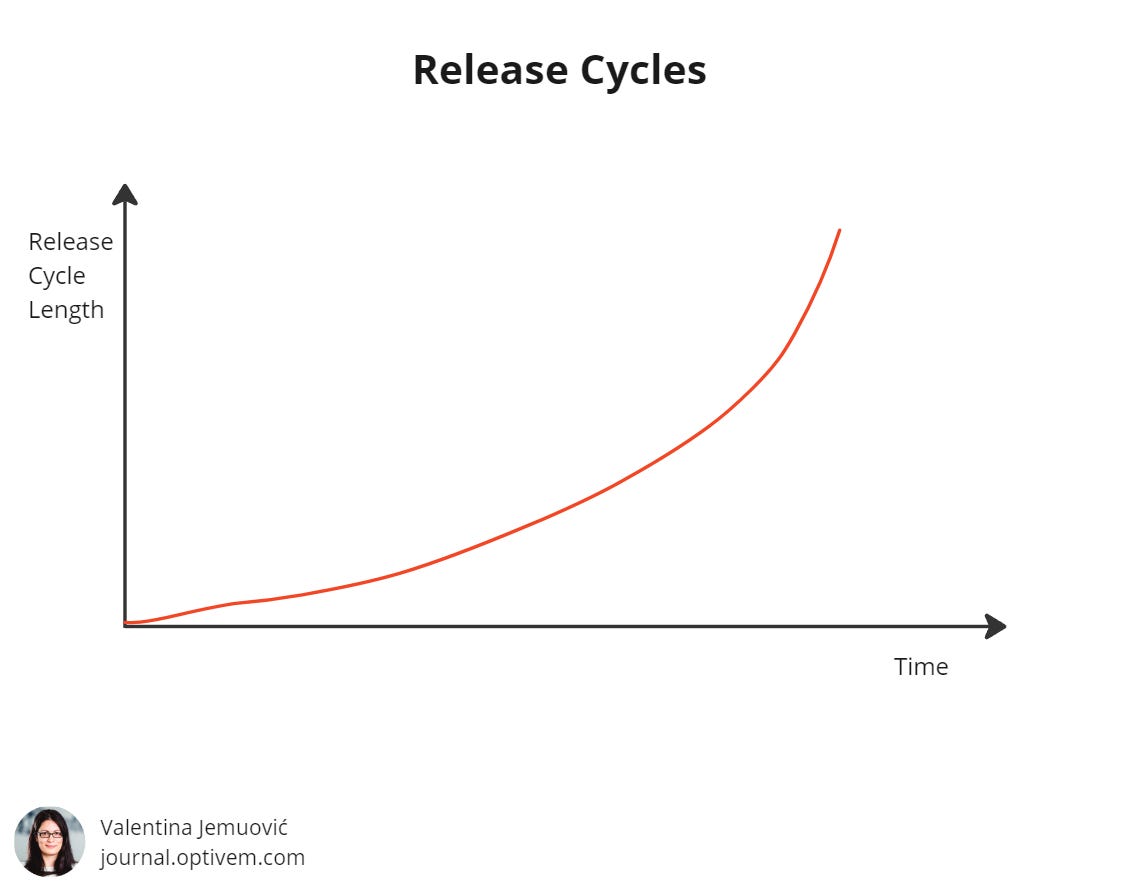Why Software Delivery is so slow?
Agile promised us fast delivery. So why are most teams still struggling with delivery speed?
👋 Hello, this is Valentina with the free edition of the Optivem Journal. I’ll help you apply TDD to escape the nightmare of Legacy Code. Join our paid community of 160+ senior engineers & leaders for support on your TDD journey, plus instant access to group chat and live Q&As:
Most companies are NOT agile. They work in a waterfall style:
Development phase
UAT & bug fixing phase
PROD & hot fixing phase
During the development phase, everything appears to be going well.
Then, in the UAT phase, everything comes crashing down. QA Engineers report numerous bugs, and developers are frantically fixing them.
Release Cycle Structure
The following is a typical structure of a Release cycle:
Development phase (multiple sprints)
UAT & bug fixing (1+ sprints):
Deployment to UAT
QA Engineers report bugs
Developers fix bugs
QA engineers re-test
Repeat
PROD & hotfixes (1+ sprint)
Deployment to PROD
Customers report bugs
QA Engineers reproduce bugs
Developers fix bugs
QA engineers re-test
Repeat
📢 On Wed 18th Jun 17:00, I’m hosting TDD & Unit Tests (Live Q&A):
P.S. If you’re a Paid Member, you’ll receive a 100% discount (see Event Description for instructions on how to redeem your 100% discount).
Releases are so slow!
Due to increased regression bugs found during UAT, it leads to greater rework costs, because the later the bug is detected, the more expensive it is to fix. The UAT Stage then takes longer and longer, causing the overall release cycle to get longer, thus delaying releases. (The problem is further worsened in the PROD stage, where the cost of rework is even greater.)
The Band-Aid Solution: Increasing headcount
Companies try to hire more developers and QA Engineers, but it’s just a band-aid solution. Over time, releases still get longer.
The Root Cause: Why Slow Delivery
Root Cause: Manual Testing
Development takes too long because developers have to spend a lot of time on debugging
UAT takes too long because QA Engineers have to spend a lot of time on Manual Testing, and Developers have to waste time during late rework (very expensive)
Root Cause: Test Last
Teams follow the waterfall approach:
PO writes requirements
Developers write code to satisfy requirements
QA Engineers test the system based on the requirements
The consequences are as follows:
During UAT, QA/PO & Developers discover late misunderstandings of requirements, thus causing higher cost of rework for developers
Before UAT, Frontend and Backend Developers experienced a lot of integration issues between themselves (as well as integration issues with External Systems) because there was miscommunication regarding their contracts, and they had to wait for each other to finish to be able to test
What’s the solution?
Solution - Part 1: (Automated) Acceptance Testing. We should translate Acceptance Criteria into Acceptance Tests, and use this as a replacement for Manual Regression Testing.
Solution - Part 2: Test Driven Approach:
TDD - System Level: By writing Acceptance Tests before coding (i.e., ATDD), it helps PO, Developers & QA Engineers reach alignment regarding requirements, thus reducing time wasted due to requirement misunderstandings.
TDD - Component Level: By writing Component Tests before coding, it helps Frontend & Backend Developers reach alignment regarding integration, thus reducing time wasted due to integration issues
Want to learn how? Read my TDD in Legacy Code series.



I’ve seen firsthand how ‘test-last’ leads to weeks of painful rework. Aligning early through executable specs (like ATDD) changes everything.
It's TDD always a good option for every project? It is a sincere question regarding about the use of TDD in a MVP project.